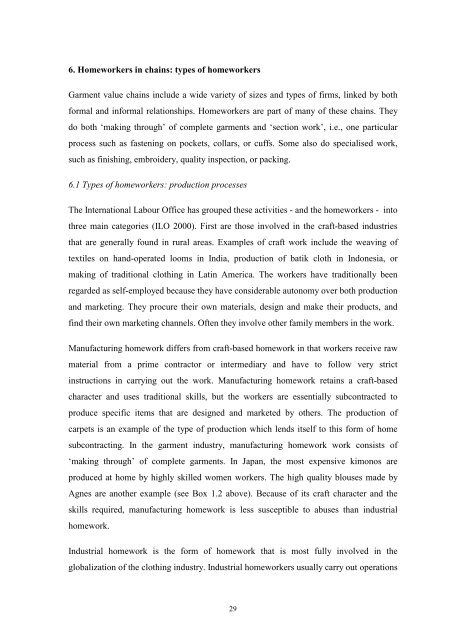McCormick+Schmitz Handbook for value chain research on - PACA
McCormick+Schmitz Handbook for value chain research on - PACA
McCormick+Schmitz Handbook for value chain research on - PACA
You also want an ePaper? Increase the reach of your titles
YUMPU automatically turns print PDFs into web optimized ePapers that Google loves.
6. Homeworkers in <str<strong>on</strong>g>chain</str<strong>on</strong>g>s: types of homeworkers<br />
Garment <str<strong>on</strong>g>value</str<strong>on</strong>g> <str<strong>on</strong>g>chain</str<strong>on</strong>g>s include a wide variety of sizes and types of firms, linked by both<br />
<str<strong>on</strong>g>for</str<strong>on</strong>g>mal and in<str<strong>on</strong>g>for</str<strong>on</strong>g>mal relati<strong>on</strong>ships. Homeworkers are part of many of these <str<strong>on</strong>g>chain</str<strong>on</strong>g>s. They<br />
do both ‘making through’ of complete garments and ‘secti<strong>on</strong> work’, i.e., <strong>on</strong>e particular<br />
process such as fastening <strong>on</strong> pockets, collars, or cuffs. Some also do specialised work,<br />
such as finishing, embroidery, quality inspecti<strong>on</strong>, or packing.<br />
6.1 Types of homeworkers: producti<strong>on</strong> processes<br />
The Internati<strong>on</strong>al Labour Office has grouped these activities - and the homeworkers - into<br />
three main categories (ILO 2000). First are those involved in the craft-based industries<br />
that are generally found in rural areas. Examples of craft work include the weaving of<br />
textiles <strong>on</strong> hand-operated looms in India, producti<strong>on</strong> of batik cloth in Ind<strong>on</strong>esia, or<br />
making of traditi<strong>on</strong>al clothing in Latin America. The workers have traditi<strong>on</strong>ally been<br />
regarded as self-employed because they have c<strong>on</strong>siderable aut<strong>on</strong>omy over both producti<strong>on</strong><br />
and marketing. They procure their own materials, design and make their products, and<br />
find their own marketing channels. Often they involve other family members in the work.<br />
Manufacturing homework differs from craft-based homework in that workers receive raw<br />
material from a prime c<strong>on</strong>tractor or intermediary and have to follow very strict<br />
instructi<strong>on</strong>s in carrying out the work. Manufacturing homework retains a craft-based<br />
character and uses traditi<strong>on</strong>al skills, but the workers are essentially subc<strong>on</strong>tracted to<br />
produce specific items that are designed and marketed by others. The producti<strong>on</strong> of<br />
carpets is an example of the type of producti<strong>on</strong> which lends itself to this <str<strong>on</strong>g>for</str<strong>on</strong>g>m of home<br />
subc<strong>on</strong>tracting. In the garment industry, manufacturing homework work c<strong>on</strong>sists of<br />
‘making through’ of complete garments. In Japan, the most expensive kim<strong>on</strong>os are<br />
produced at home by highly skilled women workers. The high quality blouses made by<br />
Agnes are another example (see Box 1.2 above). Because of its craft character and the<br />
skills required, manufacturing homework is less susceptible to abuses than industrial<br />
homework.<br />
Industrial homework is the <str<strong>on</strong>g>for</str<strong>on</strong>g>m of homework that is most fully involved in the<br />
globalizati<strong>on</strong> of the clothing industry. Industrial homeworkers usually carry out operati<strong>on</strong>s<br />
29














